| Pages:
1
2
3
4 |
woelen
Super Administrator
        
Posts: 7976
Registered: 20-8-2005
Location: Netherlands
Member Is Offline
Mood: interested
|
|
Keep doing this, each time for one minute and then measure normal current also for at least 1 minute.
|
|
|
Xenoid
National Hazard
   
Posts: 775
Registered: 14-6-2007
Location: Springs Junction, New Zealand
Member Is Offline
Mood: Comfortably Numb
|
|
Hi Jurre10
Seems to me like you have been sold an anode made from used or partly worn out MMO which may have come from old, larger factory anodes.
Does the MMO coating appear fairly thick and slightly rough or black and smooth. Worn out MMO leaves a black smooth surface.
The oxide passivation surface will breakdown if the voltage exceeds about 10 volts and the titanium will be rapidly converted to TiO2.
To see what happens, have a look at my home made MnO2 anode when the coating wore off and the voltage was allowed to rise!
http://www.sciencemadness.org/talk/viewthread.php?tid=9572&a...
The photo is at the botom of page 11 of the "Cobalt oxide anode" thread.
EDIT:
About half way down the "Thoughts on Anodes" thread is a post by dann2 where he is trying to make perchlorate using LaserReds MMO from ebay. The
electrode passivated in short time possibly due to the low chloride level. Later on, down the page, dann2 thinks the ebay MMO is second hand or poor
quality!
http://www.sciencemadness.org/talk/viewthread.php?tid=5050&a...
[Edited on 10-1-2011 by Xenoid]
[Edited on 10-1-2011 by Xenoid]
|
|
|
markgollum
Hazard to Self
 
Posts: 53
Registered: 21-2-2004
Member Is Offline
Mood: No Mood
|
|
I have had a similar experience
I have had two MMO anodes passivate/wreck on me. This was a good 3 years back so my memory is slightly fuzzy. I had run one cell for a few weeks and
had made 1-2 Kg each of NaClO3 and KCLO3 when the first anode suddenly passivated (Over the course of about a day).
The first anode had gradually built up a white, very hard, abrasive, non-uniform deposit that I could not remove or affect with hydrochloric acid,
sodium hydroxide as I recall helped but not much. I remember having a feeling that the deposit was silica. The initially shiny titanium cathode had
darkened with what I felt was a small amount of electrophoretically deposited MMO particles. However, no amount of scrubbing with plain soap and water
would clean up the cathode. The second anode was wreaked after a 3-4 days of operation in the same electrolyte. It had only a very slight amount of
the white deposit (a few bits here and there, perhaps 1% coverage) BUT the second titanium cathode was covered in the black film. The initially
slightly glossy uniformly black anode was significantly lighter in color, comparing it side by side with a new anode; it's obviously lost most of the
MMO coating.
If I were to use MMO anodes to produce chlorate again (I won't I would rather go back to graphite) I would not run KCl as an electrolyte since KClO3
builds up on the electrodes. I would also recrystalize the table salt to remove the iodide and the silicoaluminate anti-caking agent. I think some
other brands contain some kind of fluorosilicate (also bad). I was using a silicone containing TiO2 to seal the electrodes to the cell lid, which was
a ceramic tile I had carefully cut two slots into with a dremel and a diamond bit. A lexan plate with matching slots was siliconed and epoxied to the
top of the tile.
I also think that silica could enter the electrolyte by the wet chlorine oxidation of the silicone.
I have attached
"Effects of Electrolyte Impurities in
Chlorate Cells"
Presented By: Richard A. Kus
Senior Research Chemist
ELTECH Systems Corporation
16th Annual Chlorine/Chlorate Seminar
Renaissance Cleveland Hotel
Cleveland, Ohio
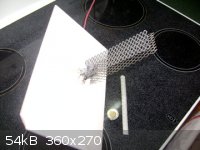
Attachment: Effects_of_Electrolyte_Impurities.pdf (712kB)
This file has been downloaded 1872 times
[Edited on 10-1-2011 by markgollum]
|
|
|
markgollum
Hazard to Self
 
Posts: 53
Registered: 21-2-2004
Member Is Offline
Mood: No Mood
|
|
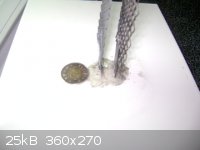
|
|
|
markgollum
Hazard to Self
 
Posts: 53
Registered: 21-2-2004
Member Is Offline
Mood: No Mood
|
|
Sorry for the multiple post
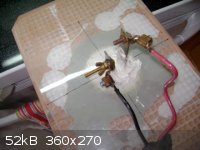
|
|
|
Xenoid
National Hazard
   
Posts: 775
Registered: 14-6-2007
Location: Springs Junction, New Zealand
Member Is Offline
Mood: Comfortably Numb
|
|
There is a post here, about halfway down page 30 of the "Thoughts on Anodes" thread, by Bikemaster. He is complaining about an MMO anode that has lost
it's coating.
http://www.sciencemadness.org/talk/viewthread.php?tid=5050&a...
He did get 8 months running out of it, in a KClO3 cell, but eventually let the chloride level drop to below 100g/litre. Again, this
may have caused the rapid decline of the MMO coating and passivation of the TiO2. Doesn't look like there is any coating whatsoever left on that
anode. 
|
|
|
Jurre10
Harmless

Posts: 17
Registered: 9-1-2011
Location: The Netherlands
Member Is Offline
Mood: Experimenting
|
|
Quote: Originally posted by Xenoid  | There is a post here, about halfway down page 30 of the "Thoughts on Anodes" thread, by Bikemaster. He is complaining about an MMO anode that has lost
it's coating.
http://www.sciencemadness.org/talk/viewthread.php?tid=5050&a...
He did get 8 months running out of it, in a KClO3 cell, but eventually let the chloride level drop to below 100g/litre. Again, this
may have caused the rapid decline of the MMO coating and passivation of the TiO2. Doesn't look like there is any coating whatsoever left on that
anode.  |
Hi,
He sais he got the same anode as me.
It's from ebay from north-star pyro, and size is 2"x6"
I think mine didn't lost he's coating, but there migth be an coating over the anode like what Swede replies on Bikemaster
Today i gonna look how the anode is, which color,rough or soft... Maybe i can upload some pictures 
Jurian
If you try your best, but you don't succeed.
Experience is what you need.
|
|
|
Xenoid
National Hazard
   
Posts: 775
Registered: 14-6-2007
Location: Springs Junction, New Zealand
Member Is Offline
Mood: Comfortably Numb
|
|
The reason I mentioned the nature of the MMO coating is that my MMO experience is wholly with swimming pool chlorinator electrodes. I get them in used
condition from a local contractor. Some look perfectly serviceable as chlorate anodes, and are very black, but when you try to use them they are
actually passivated. These would have been in use for several years.
On the other hand, some of the electrodes have totally lost the black MMO coating and are a bronze-silvery colour.
I assume your anode still looks black. Can you see any slight texture in the black coating or is it perfectly smooth. MMO has a slightly rough
texture.
Did you run the anode with low chloride concentration?
|
|
|
hissingnoise
International Hazard
    
Posts: 3940
Registered: 26-12-2002
Member Is Offline
Mood: Pulverulescent!
|
|
Quote: Originally posted by markgollum  |
If I were to use MMO anodes to produce chlorate again (I won't I would rather go back to graphite) I would not run KCl as an electrolyte since KClO3
builds up on the electrodes. I would also recrystalize the table salt to remove the iodide and the silicoaluminate anti-caking agent.
|
Yes, graphite (bought from a company specialising in contact brushes) gave me good results!
Cheaper rods disintegrated rapidly but they were made of compressed carbon powder with some kind of polymer binder which couldn't be filtered off.
I used to recrystalise salt by chilling a saturated solution to -20*C!
A fairly slow business but purity more or less guaranteed . . .
|
|
|
woelen
Super Administrator
        
Posts: 7976
Registered: 20-8-2005
Location: Netherlands
Member Is Offline
Mood: interested
|
|
The remark about using NaCl instead of KCl is one which I do not agree with. I already did around 10 runs, both with KCl and with CsCl and in all runs
no crust of material settles at the anode. The huge advantage of using KCl is that you directly get crystals of KClO3 and workup is much easier. You
also get a product which certainly is free from Na-ions, allowing good colors in pyro-compositions.
I did have formation of crusts on the anode when KBr is used for making KBrO3, but with KCl no such problems exist.
Apparantly the clue to preventing problems is to assure that concentration of chloride does not decrease too much. I always stopped electrolysis when
the current dropped to approximately half the value it has on its maximum. Apparently low chloride concentration leads to passivation of the anode.
|
|
|
Jurre10
Harmless

Posts: 17
Registered: 9-1-2011
Location: The Netherlands
Member Is Offline
Mood: Experimenting
|
|
Hi,
Thanks for all answers.
My MMO anode looks as follows : black and really soft, it also feels soft, not rough.
Jurian
If you try your best, but you don't succeed.
Experience is what you need.
|
|
|
Jurre10
Harmless

Posts: 17
Registered: 9-1-2011
Location: The Netherlands
Member Is Offline
Mood: Experimenting
|
|
hi,
Just reversed polarity few times for 1min each time.
...0.90A,1.0A,1.1A so i think this is the way to make it better.
Jurian
If you try your best, but you don't succeed.
Experience is what you need.
|
|
|
dann2
International Hazard
    
Posts: 1523
Registered: 31-1-2007
Member Is Offline
Mood: No Mood
|
|
Hello Folks,
It would be an understatement to say that I hope Swede gets back on his feet soon.
Sometimes the only way to get some extra time, if needed, when involved in the 'Chlorate and Perchlorate' business is to shut everything down and STAY
COMPLETELY AWAY from the scene!
Great read that paper on Chlorate DSA impurity problems. It covers alot of ground that I have not seen before anyways.
Just wondering if you were to view the DSA under ultraviolet light would it perhaps show up some problems clearer.
I do not have alot of experience with MMO. I ran a piece of corrosion control MMO (Ti wire covered in a black coating of MMO which was Ta Oxide + Ir
Oxide especially made for working as a corrosion control Anode) in a Perchlorate cell for approx. 25 days and it did not passivate. Some of the
coating wore off in places though.
It's a wonder that DSA works at all in an Amateur environment after reading all the possible problems that crop up with impurities!
I would guess that Jurre10's DSA has passivated or partially passivated, some TiO2 has managed to form between the MMO's and the Ti substrate. Just
reading your last post that the MMO is soft?? Perhaps you mean smooth? There are many types and textures and colours for MMO. Perhaps the pool
chlorinations have some Ir Oxide in them.
That stuff is black. The Ir Oxide (perhaps together with Tantalum Oxide as opposed to Ti Oxide is better for
use where very low contentration of salt in encountered. (Swimming pools, corrosion controll applications). They are used at low current density
though I think (when used in the swimming pools etc.) Just wondering Xenoid do
you know what current density the pool Anode are worked at in a pool?
A wire Anode for corrosion control that I had (Ir and Ta Oxide) was 100% smooth when new and black in colour.
What was the ebay source? (Answered above it's new) If the stuff is not new then obviously it's quality is completely unknown like the stuff
'Laserred' was selling (though he (to be fair) was really selling the stuff as Ti mesh that happened to have an MMO coat on it).
A piece of 'Laserred' MMO that I was using to see how %CE was in a Chlorate cell as Chloride concentration went lower and lower, passivated after
approx. 9 days of operation.
It definitely was passivation (the MMO layer was still there, the TiO2 managed to appear on the Ti between the two) as no amount of 'cleaning' would
make any difference.
Cleaning MMO with steel wool/sandpaper/ or whatever is hopeless IMO (if it's a layer that is on there) because you are only going to get rid of the
layer is places. It would have to be a chemical for the cleaning to be successful.
(Looking at Marks system) the one Anode and one Cathode is a bad system IMO. Better to have two (small) Cathodes for good current distribution on the
Anode.
Contact brushes ('Graphite')sometimes contain Copper so watch out for that!
There is another file about brine treatment from here:
www.chlorimax.com/pdfs/Brine_Treatment.pdf
The history bit is a bit hilarious.
____________________________________________
HISTORY
The Chinese were drilling wells for salt water in 2000 B.C.. The Chinese emperor Yu made the
royal decree that his subjects would supply his court with salt. (Hence the term "rubbing salt in a
wound" was coined referring to an early version of the IRS.) Roman soldiers were paid partly in salt
- or salaria. Our word salary and the expression, "not worth his salt," can be traced to the Roman
word salaria.
History is filled with references to salt. The Bible contains 32 references, the most familiar
probably being the story of Lot's wife who was turned into a pillar of salt when she disobeyed the
angels and looked back at the wicked city of Sodom. The widespread superstition that spilling salt
brings bad luck is believed to have originated with the overturned saltcellar in front of Judas Iscariot
at the Last Supper, an incident immortalized in Leonardo Da Vinci's famous painting.
In 1553 an English traveler visited Venice and noted the following legislation. "Neither may any
man in Venice buy more salt then he spendith in the city for if he be known to carry it out of the city
and be accused, therefore he loseth an ear." Salt is still used today as a means of exchange.
In West Africa, a man can buy a wife for 48 pounds of salt.
In Ethiopia, hunters exchange skins for salt. In 1584, Jean D. Marcounille said, "... the sacredness
and dignity of salt. This mineral is like unto
the four elements: earth, air, fire, and water. So universal, so necessary to life, it is the fifth
element."2
Our bodies contain 2% salt. It acts as a policeman patrolling our blood streams and keeps our fluids
in chemical balance. If all the salt was removed from our bodies, we would not live 48 hours.
Today, the uses of salt are manifold. Of the 25 million tons produced annually in the United States,
about 71% or 18 million tons are consumed by the chemicals industry in producing chlorine,
caustic soda, hydrochloric acid, sodium, and some 30 other basic chemicals. These basic
chemicals are used in the preparation of 14,000 other chemicals. In addition, large amounts of salt
are consumed by meat and fish packers, in water softening, road stabilization, ice and snow removal,
and recovery of bromine from seawater.
___________________________________________
I will not be posting for quite some time. I am going off to West Africa with a Matilda (I will Waltz the Matilda all of the way) packed with 48
pounds of salt to obtain myself a Wife!!!!!!
Dann2
Google Waltzing Matilda
[Edited on 10-1-2011 by dann2]
|
|
|
Jurre10
Harmless

Posts: 17
Registered: 9-1-2011
Location: The Netherlands
Member Is Offline
Mood: Experimenting
|
|
Hi,
Woohoo! a reply from THE dann2 everyboddy is talking about! 
I'm sorry but i don't have an ultravioletlamp or something like that.
You'r right i mean black and smooth. not soft.
I buyed 2 anodes that aren't used (hopefully its true)
Is it a good idea to use the two anodes, two cathodes methode? or do you prefer one anode, two cathodes?
So it might be something like: its not a layer but some componements of the anode have changed?
But wy can i get a lower resistance by reversing polarity for a short time? because anode bubbles wrong componements off?
Greetz,
Jurian
If you try your best, but you don't succeed.
Experience is what you need.
|
|
|
dann2
International Hazard
    
Posts: 1523
Registered: 31-1-2007
Member Is Offline
Mood: No Mood
|
|
Hello Jurian
Each side of the Anode should have a view of a Cathode. When you just put one Cathode into the cell the side of the Anode that is beside the Cathode
is going to have a greater current density that the side that is not beside the Cathode. This will give uneven wear of the Anode. You can see the
effect clearly when using Graphite as the Graphite is inclined to wear more on the side beside the single Cathode. Perhaps I am too particular.
Instead of installing one Cathode of size x, simply cut the Cathode and install two Cathods of size x/2, one each side of the Anode.
Ti (and Ta, Nb, Zr) are 'Valve' metals. When used as a Cathode in an electrolyte the current will pass from the electrolyte into the Ti. It seems to
go 'through' the Ti Oxide layer. When you reverse the current (the Ti is now the Anode) the current stops flowing. The current refuses to go from the
Ti, through the Oxide layer, and into the electrolyte.
(taking conventional direction of current going from + to -)
I must google up an explanation of how/why this actually works in detail.
Ti looks like a diode (a valve* if you are old enough) when put into an electrolyte and you start passing current in each direction. It won't rectify
50Hz ac as the 'diode' has very very slow recovery
So when you use Ti as a Cathode it always works, Oxide layer or no Oxide layer. When you use Ti as an Anode no current will flow as the Oxide layer
stops the current from flowing. If a piece of (useless) passivated (layer of Ti Oxide between the MMO and the Ti substrate) DSA is used as a Cathode
it will work OK. When the pasivated DSA is used as an Anode the current just 'sees' the Oxide layer and does not flow.
If you put the Voltage high enough the Oxide layer will be destroyed and current will start to flow and Ti metal will get eaten away. You need
approx. 16 Volts for Ti (semi guess). Ta Oxide is able to withstand about 50 Volts.
Try using the DSA Anode as a Cathode for half an hour or so to see if there is a layer that will go away (this layer has to be on the very external
surface of the MMO).
If Ti Oxide has managed to form between the MMO layer and the Ti substrate then you DSA Anode is not an Anode anymore but just a piece of Ti. No
amount of using the DSA as a Cathode will get rid of the Ti Oxide (if it is there).
A bit of a rambling post.
Dann2
[Edited on 11-1-2011 by dann2]
|
|
|
markgollum
Hazard to Self
 
Posts: 53
Registered: 21-2-2004
Member Is Offline
Mood: No Mood
|
|
@ dann2
Yes, I would agree that 2 cathodes are better than one.
@woelen
I would also agree with woelen that its possible to set the cell up so that no KClO3 crystals form on the electrodes. However, I think it would be
necessary to design the cell so that it has good circulation so that the crystals easily form on the cooler surfaces. Of course, the
circulation/mixing of the electrolyte is important for other reasons as well. Poor mixing was a fault of my cell as it was a tall cylinder, it now
seems likely that my cell could have been running at a localized low chloride concentration. I had read all of the stuff on Wouter Visser's page,
whatever dann2 had up at the time, everything on the E&W forum, as well as Sciencemadness so I really should have known better . .
What I was trying to accomplish at the time was to focus on trying to build a clean, low maintenance cell. I was concentrating on solving the salt
creep and sealant (epoxy, silicone, I tried so many brands and types) problems that had plagued my previous attempts.
I also got my anodes from northstar pyro on Ebay. I had bought 3 MMO anodes, one tubular Ti substrate Pt coated anode, and a Niobium mesh Pt coated
anode. I have never used my Pt anodes.
I still have one more MMO anode, but I am saving it so that perhaps one day I can plate it with lots of PbO2.
|
|
|
woelen
Super Administrator
        
Posts: 7976
Registered: 20-8-2005
Location: Netherlands
Member Is Offline
Mood: interested
|
|
Indeed, you have to assure that KClO3 crystallizes on colder places. For that reason I put my cell in a layer of water, which nicely cools down the
cell (otherwise it becomes too hot), but the cell is not completely immersed in water. Approximately 75% is under water. The coldest part of the cell
then will be the bottom and that is where KClO3 crystals are formed. No crystals at all are formed at the anode and cathode in such a setup.
|
|
|
metalresearcher
National Hazard
   
Posts: 731
Registered: 7-9-2010
Member Is Offline
Mood: Reactive
|
|
Another option is putting the cell into the fridge (or in the freezer). Of course after running the electrolysis.
[Edited on 2011-1-11 by metalresearcher]
|
|
|
metalresearcher
National Hazard
   
Posts: 731
Registered: 7-9-2010
Member Is Offline
Mood: Reactive
|
|
Here a test run still with graphite rod (MMO anode not received yet).
It is a 300ml "Calvé Pindakaas" peanut butter jar very suitable for this test.
The lid is sealed with sanitary caulking.
Voltage: 5.2V, current 10 A (meter has a 80/1 scale).
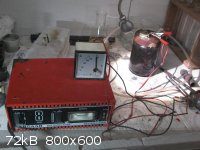
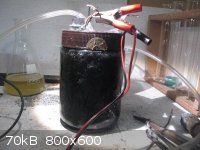
Contents look very dark now after less than an hour while is was yellow at the start (due to the K2Cr2O7).
|
|
|
mr.crow
National Hazard
   
Posts: 884
Registered: 9-9-2009
Location: Canada
Member Is Offline
Mood: 0xFF
|
|
I also bought one of those eBay MMO on titanium anodes a while ago from the States. It was total crap, didn't conduct electricity when I put it in the
solution. I swapped it out for a regular piece of metal and conducted just fine, but was quickly corroded. Maybe the MMO needs to be activated?
Double, double toil and trouble; Fire burn, and caldron bubble
|
|
|
dann2
International Hazard
    
Posts: 1523
Registered: 31-1-2007
Member Is Offline
Mood: No Mood
|
|
Hello,
@ Mr Crow
Who was it from? I would thinK North Star Pyro sell perfectly OK new Anodes.
Going back to the 'Valve metal thing'
The paper below explains why Valve metals (Ti and Nb anyways) conduct from Cathode (-) to electrolyte
and not from Anode(+) to electrolyte. Hydrogen doping of the Oxide film seems to be the reason. When used as
a Cathode, Hydrogen diffuses into the non-conducting TiO2 making it condutive. When used as an Anode
there is no Hydrogen so the TiO2 remains an insulator. Google will get the artical.
Electrocomponent Science and Technology
1974, Vol. 1, pp. 121-127
ELECTROLYTIC RECTIFICATION AND CATHODIC
CHARGE REVERSIBILITY OF SOME VALVE METALS
Going back to using MMO as a Cathode, somewhere in the 'Thoughts on Anodes' thread I think I posted info. from a pool
chlorination site on the time frame that was used to reverse the polarity of bipolar pool chlorinators for to clean them.
I don't think using MMO as a Cathode (to clean it) will do it any harm.
|
|
|
Xenoid
National Hazard
   
Posts: 775
Registered: 14-6-2007
Location: Springs Junction, New Zealand
Member Is Offline
Mood: Comfortably Numb
|
|
Quote: Originally posted by dann2  |
Going back to using MMO as a Cathode, somewhere in the 'Thoughts on Anodes' thread I think I posted info. from a pool
chlorination site on the time frame that was used to reverse the polarity of bipolar pool chlorinators for to clean them.
I don't think using MMO as a Cathode (to clean it) will do it any harm. |
Dann2, perhaps your mind is wandering, are you referring to this post of mine from a few weeks ago!
Quote: Originally posted by Xenoid  | All the pool chlorinator electrode assemblies from around here are now wholly manufactured from MMO. This is because they are all self cleaning now,
so that the electrode polarities are switched back and forth regularly to stop build-up on the cathode. This also simplifies construction and
inventory for the chlorinator companies as they don't need to worry about plain Ti electrodes.
I am currently running a 5 litre chlorate cell with an all MMO 10 element pool chlorinator electrode. I switch polarity two or three times per run at
which time any whitish "crud" that has built-up on the cathode immediately flakes off when it becomes the anode.
Incidentally, I now note most companies are switching over to solid plate electrodes rather than mesh, they last longer I guess.
MMO is now so cheap and common  |
Perhaps to summarise, the use of MMO by amateurs is not without its pitfalls :
1. MMO being sold on ebay which may be "seconds" or low quality, or perhaps "used" to more or less extent!
2. Don't use MMO in low chloride environment, keep adding chloride to your cell.
3. Remember MMO of various compositions is not stable in a high pH environment (ie. an uncontrolled amateur cell). Industrial users can get 10 year
lifetimes only by tightly controlling the pH just below 7. There are reports of MMO anodes losing 25% of their coating in just a few hours when
industrial pH control has gone haywire 
|
|
|
metalresearcher
National Hazard
   
Posts: 731
Registered: 7-9-2010
Member Is Offline
Mood: Reactive
|
|
Quote: Originally posted by Xenoid  | Industrial users can get 10 year lifetimes only by tightly controlling the pH just below 7. There are reports of MMO anodes losing 25% of their
coating in just a few hours when industrial pH control has gone haywire 
|
How can I achieve this ? In a chlorate cell LOTS of OH- appears which will turn up the pH to fay beyond 10.
Adding HCl ?
Or, better buy a more expensive Pt foil anode (current price $2000/tr oz == $60/g).
[Edited on 2011-1-12 by metalresearcher]
|
|
|
woelen
Super Administrator
        
Posts: 7976
Registered: 20-8-2005
Location: Netherlands
Member Is Offline
Mood: interested
|
|
Add some K2Cr2O7 and occasionally add a drop of HCl. This will keep the pH lower. Dichromate has some buffering action, HCl of course brings pH down.
But adding of HCl should be done cautiously. You don't want the pH going down too much, as that will lead to desctruction of chlorate and formation of
free chlorine.
My experience is that adding some K2Cr2O7 keeps the pH already much better under control.
|
|
|
metalresearcher
National Hazard
   
Posts: 731
Registered: 7-9-2010
Member Is Offline
Mood: Reactive
|
|
@woelen:
Thanks. I already have a knifetip of K2Cr2O7 (in 300ml) in the solution so the color is piss-yellow.
I'll check the pH tonight.
My girlfriend saw this and said: "You have to piss into the loo not into a jar ;-)"
|
|
|
| Pages:
1
2
3
4 |